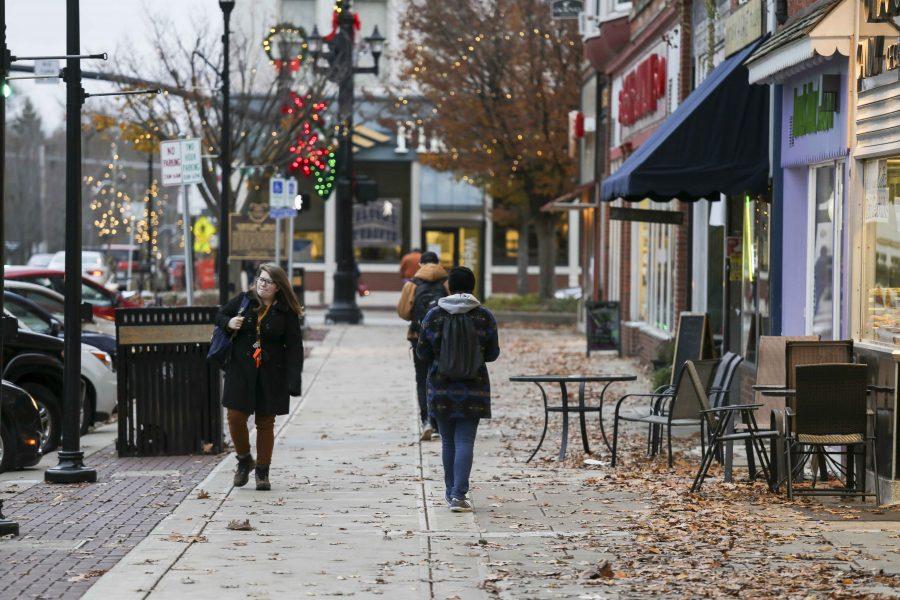Local Arrest Raises Police Bias Concerns
Photo by Rick Yu, Photo editor
People walk past Agave Burrito Bar and Tequileria on West College Street. Local resident Brae Chamberlin was arrested Nov. 19 around 1 a.m. for skateboarding on the street and sidewalk by the restaurant, an offense police call “Toys in the Street.”
December 2, 2016
In response to the arrest of Oberlin resident Brae Chamberlin, 21, students silently protested outside the Oberlin Police station Nov. 22, claiming local police acted with racial bias when arresting him.
Chamberlin, who is Black, and Justin Montique, 23, were skateboarding in the street in front of Agave Burrito Bar and Tequileria on the evening of Friday, Nov. 19 when a police car drove up to them. After issuing a warning and then discovering Chamberlin and Montique skateboarding in the street just minutes later, police separated the two and said they would issue citations for the offense.
According to body camera footage on the main police officer, Chamberlin began cursing and yelling at the officer, claiming that the citation was unfair, causing the officer to arrest him for disorderly conduct. Chamberlin was then handcuffed and taken to the station before being immediately released. Montique, who is white, was let go with just a citation for the skateboarding.
Friends and student bystanders said they believed this was a case of racial bias by police, as they only arrested Chamberlin despite Montique allegedly also cursing and acting uncooperatively.
One of Chamberlin’s friends who witnessed the incident is College senior Delaviz Eftekhar, who believes the police could have handled the situation better.
“Brae was reaching for his skateboard, and I get that, but I think the cops could’ve deescalated it before it got to the point where he was feeling unsafe, which influenced him to keep holding his board,” Eftekhar said.
From the police perspective, Oberlin Po lice Chief Juan Torres felt the situation was handled correctly, as the body camera footage shows Chamberlin yelling and cursing much more freely at the officers than Montique.
“I believe he told him to put the skateboard down two or three times, and he refused, so at that time the officer was justified to bring him into the station,” Torres said. “The other student was also issued the same warning, but he cooperated with the officer fully.”
Delaviz and other students organized a silent protest in front of the police station and courthouse the morning of Nov. 22, when Chamberlin had his court hearing and pleaded not guilty. Approximately 25 attended the protest, with several holding up signs that read, “End racial profiling,” “No racist police” and “Black Lives Matter.”
Even though the turnout was not as large as that of the Gibson’s Bakery protest, Delaviz said he thought the silent protest made an impact, as the judge noted the protesters while interacting with Chamberlin at his hearing.
“Brae said, ‘This is racist,’ and the judge responded saying, ‘Well, you have a group out there that seems to agree with you,’ so I think it made a statement,” Delaviz said.
Before the protest, Torres met with Delaviz and other students to discuss the incident and reassured them that he would increase police bias trainings and would hold a meeting with students next semester on police-student relations. Torres also offered to give students ride-alongs with officers to demonstrate how they deal with each incident.
According to Torres, state officials have recently been focusing on racial bias and have increased required trainings on the issue. In an email to the Review, Torres listed a number of training courses Oberlin police officers take to ensure they treat civilians fairly, including one called “Verbal Judo,” which refers to a book about defusing argumentative conversations peacefully.
With Donald Trump’s recent nomination, Delaviz believes the protests were created in part as a way to ensure that racially based injustices don’t become the norm.
“I don’t want these acts to be normalized, and since the election there have been a lot of examples of explicit racism, nationally and in Oberlin,” Delaviz said. “So the protests were definitely inspired by [Trump’s nomination].”
With this protest coming on the heels of the Gibson’s protest, it represents a growing concern that there is a distinct separation between students and locals. While some locals and Gibson’s supporters have allegedly called student protesters “spoiled” and too quick to accuse people of racism, Torres said police will continue to facilitate protests and that the department has no problems with the public demonstrations.
“They have every right to protest, and I’m impressed that they’re exercising their constitutional rights,” Torres said. “They’re behaving fine and the students are an important part of this community. There are no strangers or visitors in this community.”
























